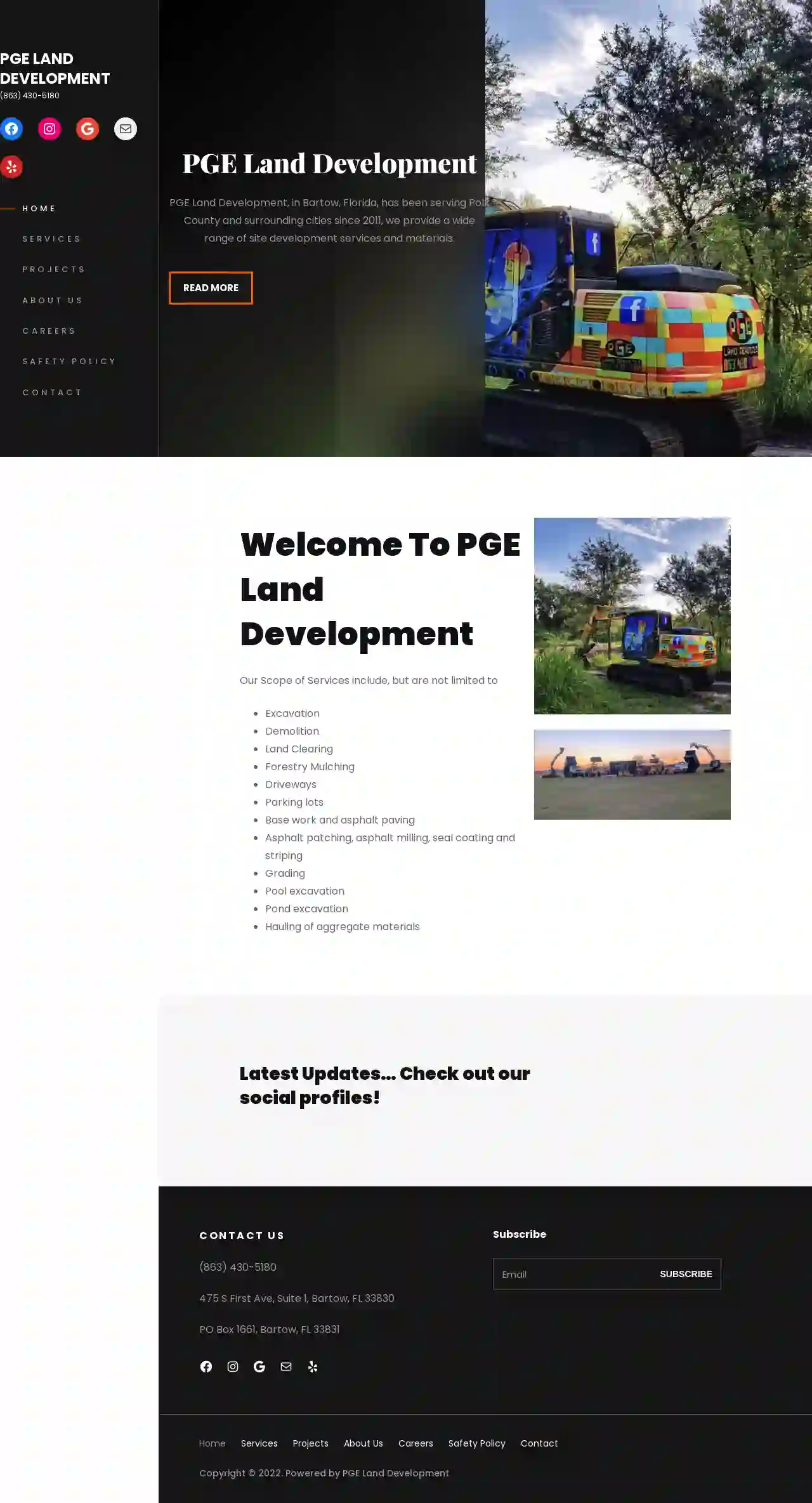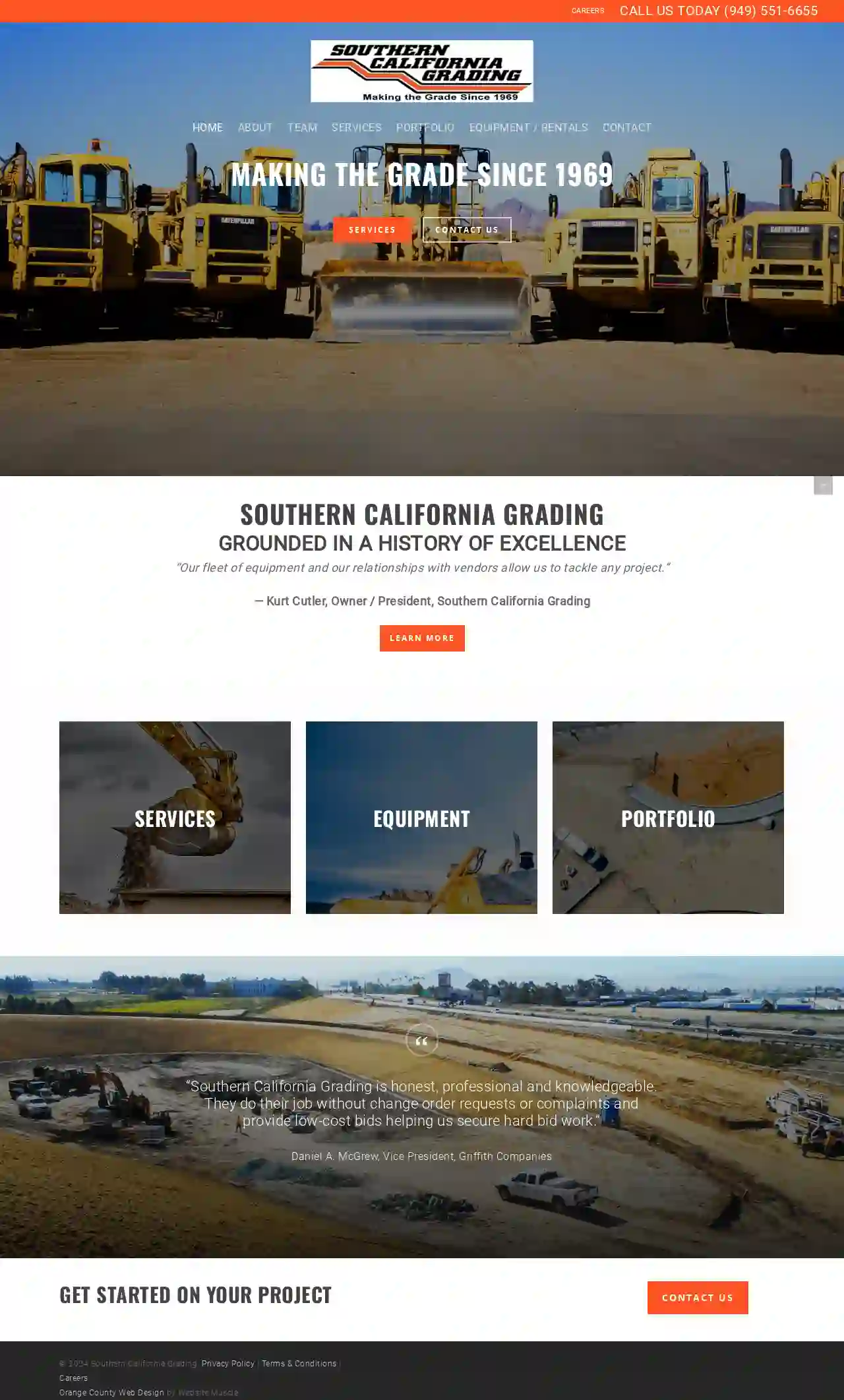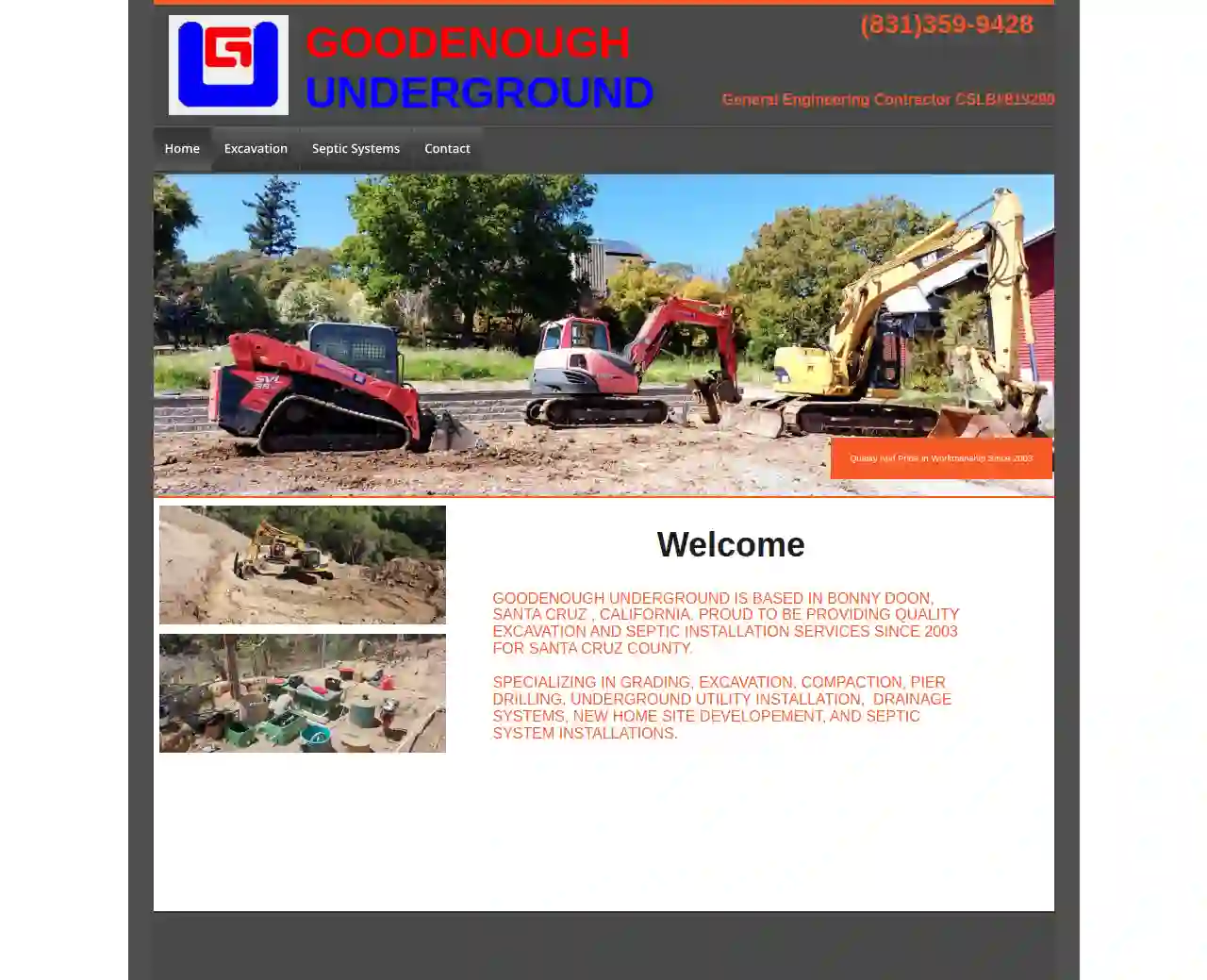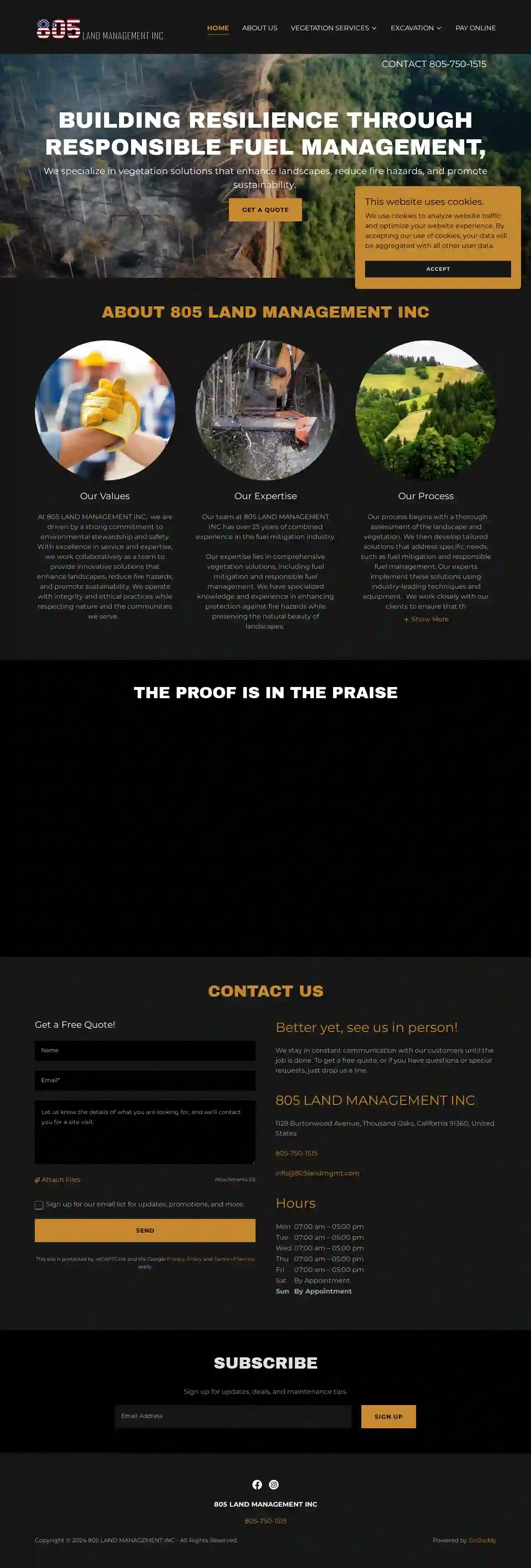Demolition Contractors West Whittier-Los Nietos
Top Demolition Contractor in West Whittier-Los Nietos
Get multiple Demolition Company Near Me quotes for your project today! Compare profiles, reviews, accreditations, portfolio, etc... and choose the best deal.

PGE Land Development
4.713 reviews475 S First Ave, Suite 1, Bartow, USPGE Land Development PGE Land Development, based in Bartow, Florida, has been serving Polk County and surrounding areas since 2011. We offer a comprehensive range of site development services and materials. Our founder, Kevin Cutts, grew up in the site development industry, gaining hands-on experience from a young age. His passion for the industry and commitment to continuous learning have driven PGE's growth and evolution. In 2011, Kevin established PGE with the vision of building a legacy for his children. Since then, PGE has helped countless customers bring their dream projects to life. Kevin remains dedicated to providing exceptional customer service and upholding the core values that define PGE.
- Services
- Why Us?
- Our Team
- Gallery
Get Quote
Niehaus Earthmoving LLC
51 reviewsOakland, USOur Company At Niehaus Earthmoving LLC, our mission is to provide top-quality earthwork services that exceed our clients' expectations. We strive to deliver projects on time, within budget, and to the highest standards of safety and quality. Our Experience With over 15 years of experience in the mass-excavation and grading industry, our team has the skills and expertise to handle any job, no matter how complex. We've worked on projects start to finish ranging from city streets to large-scale commercial developments, Ag production facilities, wind/solar farms, landfills, wetland restorations, river diversions, waste management lagoons, heavy highway and interstate construction. Our Services We offer a comprehensive range of earthwork and demolition services including site preparation, excavation, grading, and compaction. We also provide dust control, erosion control, and slope stabilization measures to ensure the longevity of your project. " We Move The Earth " Initiation - Planning - Execution We are able to provide efficient and cost-effective grading services to ensure your project is completed on time, on budget and to your satisfaction. We provide expertise in, in-house site design such as building sites, drainage, and roads. We can meet any vigorous project scheduling demands. Contact us today to discuss your project needs and receive an estimate.
- Services
- Why Us?
- Our Team
- Gallery
Get Quote
US Trenchless Inc.
4.971 reviews5716 Folsom Blvd., #290, Sacramento, 95819, USUS Trenchless: Your Trusted Partner for Trenchless Plumbing Solutions US Trenchless is a leading provider of trenchless plumbing services in Sacramento, CA. We specialize in a wide range of services, including sewer line repair, replacement, and inspection, as well as water line repair and replacement. Our team of experienced and certified technicians is committed to providing our clients with the highest quality service and workmanship. Why Choose US Trenchless? We understand that plumbing issues can be stressful and disruptive. That's why we strive to make the process as easy and hassle-free as possible for our clients. We offer: Free estimates 24/7 emergency service Competitive pricing A 100% satisfaction guarantee Our Services We offer a wide range of trenchless plumbing services to meet the needs of our residential and commercial clients. Our services include: Sewer line repair and replacement Water line repair and replacement Pipe bursting Horizontal directional drilling Sewer line inspection Hydro jetting Water heater installation and repair Water softener installation Water filtration system installation Our Team Our team of experienced and certified technicians is dedicated to providing our clients with the highest quality service and workmanship. We are committed to using the latest technology and techniques to ensure that our work is done right the first time. Contact Us Today If you are experiencing a plumbing issue, don't hesitate to contact US Trenchless. We are available 24/7 to provide you with the help you need. Call us today for a free estimate.
- Services
- Why Us?
- Our Team
- Testimonials
- Gallery
Get Quote
Urban Irvine Construction
56 reviewsSuite A, 16291 Construction Circle East, Irvine, 92606, USGrounded in a History of Excellence Southern California Grading was founded in 1969 by Bob Cutler and Bob Kehrer—two friends with extensive hands-on engineering and earthwork experience. In our early days, when Orange County was just starting to grow, we forged strong relationships with developers like the Irvine Company. Successful projects ranging from commercial ventures to developing new roads made Southern California Grading essential to bringing people and businesses to Irvine. These efforts began decades-long relationships with our clients and peers in the construction community. A Legacy of Teamwork and Mutual Respect Based in Irvine, California, Southern California Grading is still family-owned, and we pride ourselves on the core values of teamwork and mutual respect. Over the years, we have developed strong relationships with many clients and devoted employees. Some have been with us for over 25 years. Southern California Grading at a Glance $25 million in annual revenues Bondable and insured with an A+ rating Banks with one of the largest U.S. financial institutions Owns and rents its own fleet of heavy equipment Diverse market expertise Our Commitment to Excellence Our core principles of integrity, respect, responsibility and hard work have made us a premier provider of grading and construction services since 1969. We enjoy the challenge of navigating the ups and downs of our industry by focusing on client needs and adapting to industry advancements. A Firm Foundation for Success Today, Southern California Grading has a long history of successful projects throughout California. We’re proud of our reputation as a company that reliably provides a firm foundation for even the most complex building projects. Our experienced employees, technologically advanced equipment, and proven procedures provide assurance that the project will be completed on-schedule, within budget and done right, the first time.
- Services
- Why Us?
- Accreditations
- Gallery
Get Quote
Saunders Landscaping Construction
53 reviewsSacramento, USWelcome to Saunders Landscaping Construction Where creativity and attention to detail are the cornerstones of our success. Our Mission At Saunders Landscaping Construction, our mission is to bring joy, endless possibilities, and luxurious design to every project we undertake. By focusing on your personal design preferences, outdoor space expectations, and plans for relaxation and entertainment, we aim to earn your trust and business for years to come.
- Services
- Why Us?
- Our Team
- Testimonials
- Gallery
Get Quote
Noecon
53 reviewsSan Jose, USNOECON General Engineering Contractor NOECON is a family-owned, operated and supervised company based in Northern California. We are licensed, bonded, and fully insured. Our mission is to serve our clients with the highest level of quality on every project. We do this through exceptional workmanship, attention to detail, timeliness, professional integrity, and care for safety while staying within our client’s budget. We value the importance of our relationships with all of our clients. Our Promise We stand by our promise to deliver high quality services, and we strive for excellence every day on each and every project. You can be 100% confident that you’re going to get the best service at the most competitive prices in Silicon Valley. Some companies have you choose great quality or cost-efficiency. We give you both. Only NOECON delivers demolition, hauling and excavation projects with true high quality. And with NOECON, you don’t have to worry about getting permits or creating site plans, we do it all. So you can focus your attention on more important things – like getting a good night sleep.
- Services
- Why Us?
- Gallery
Get Quote
GOODENOUGH UNDERGROUND INC.
57 reviewsBonny Doon, USGOODENOUGH UNDERGROUND IS BASED IN BONNY DOON, SANTA CRUZ , CALIFORNIA. PROUD TO BE PROVIDING QUALITY EXCAVATION AND SEPTIC INSTALLATION SERVICES SINCE 2003 FOR SANTA CRUZ COUNTY. SPECIALIZING IN GRADING, EXCAVATION, COMPACTION, PIER DRILLING, UNDERGROUND UTILITY INSTALLATION, DRAINAGE SYSTEMS, NEW HOME SITE DEVELOPEMENT, AND SEPTIC SYSTEM INSTALLATIONS.
- Services
- Why Us?
- Our Team
- Gallery
Get Quote
805 Land Management Inc.
52 reviews1128 Burtonwood Avenue, Thousand Oaks, 91360, USBuilding resilience through responsible fuel management We specialize in vegetation solutions that enhance landscapes, reduce fire hazards, and promote sustainability. About 805 LAND MANAGEMENT INC At 805 LAND MANAGEMENT INC, we are driven by a strong commitment to environmental stewardship and safety. With excellence in service and expertise, we work collaboratively as a team to provide innovative solutions that enhance landscapes, reduce fire hazards, and promote sustainability. We operate with integrity and ethical practices while respecting nature and the communities we serve. Our Expertise Our team at 805 LAND MANAGEMENT INC has over 25 years of combined experience in the fuel mitigation industry. Our expertise lies in comprehensive vegetation solutions, including fuel mitigation and responsible fuel management. We have specialized knowledge and experience in enhancing protection against fire hazards while preserving the natural beauty of landscapes. Our Process Our process begins with a thorough assessment of the landscape and vegetation. We then develop tailored solutions that address specific needs, such as fuel mitigation and responsible fuel management. Our experts implement these solutions using industry-leading techniques and equipment. We work closely with our clients to ensure that their vision is brought to life. We provide regular updates throughout the project and are always available to answer any questions.
- Services
- Why Us?
- Gallery
Get Quote
EARTHTEK Grading and Paving
4.915 reviews39899 Balentine Dr, Ste 200, 39899 Balentine Dr Ste 200, Newark, 94560, USSan Jose's Leading Asphalt Contractor Full Service Asphalt, Concrete & Site Work. Residential & Commercial Free Estimate EARTHTEK 5-Star Paving Company in San Jose When you’re looking for the best in asphalt, concrete, and site-specific operations, the EARTHTEK crew offers the experience, skill, and dedication you can rely on. When you absolutely need to make sure your project is done on time, within budget and correctly, we have you covered. Our commitment to our clients is what makes us one of the best asphalt contractors in San Jose. Whether your project is simple driveway sealcoating or a 100,000 stall parking lot, the team at EARTHTEK is equipped to handle it. We are a family-owned and operated company that is fully licensed and insured. Our years of operation combined with high-quality materials means you’ll be able to rely on our work decades to come. Why Choose Us EARTHTEK is a family owned and operated paving company local to the San Jose. The services offered by us are custom designed and planned out to fit your specific needs while we aim to maintain and build upon your area’s surrounding beauty. That being said, we know what we’re doing and we won’t waste your time bogging you down with an avalanche of phone calls, texts, or in-person meetings. We know you have things you need to take care of outside of your paving needs and that many items on your agenda far outweigh micromanaging your concrete work. Our reputation speaks for itself - and our customer feedback has given that reputation a megaphone. Get in touch with us today to start discussing your concrete and asphalt needs.
- Services
- Why Us?
- Testimonials
- Gallery
Get Quote
Cloud 9 Services, A Wind River Environmental Company
4.776 reviews1201 West Jackson St, Orlando, 32805, USUnderground Utilities Experts SERVICING COMMERCIAL, INDUSTRIAL, AND MUNICIPALITY INDUSTRIES GET A QUOTE Cloud 9 Services LLC is the underground plumbing and utility company that commercial, industrial, and municipal HOAs and property managers all over Florida consistently turn to. As a licensed and certified company that specializes in mechanical, plumbing, and underground utility (Drain Cleaning) and excavation, we stand out against our competitors. One reason why we have become the leading utility company in Florida is because we never close. Our customers can get in touch with us during an emergency at any time of the day or night. However, being able to get in contact with us at any time is just one of the benefits of working with Cloud 9 Services LLC. No other business in the Florida area performs mechanical, plumbing, and underground utility work with as much precision and skill as we do. Sometimes, finding the root of an underground plumbing issue can be difficult because these issues arise in an area that cannot be seen easily. At Cloud 9 Services LLC, we are able to find the root of any problem and solve any type of issue with ease and efficiency. Not only are we able to solve any sort of underground plumbing issue with drain cleaning, but the services we offer our customers are comprehensive and varied. No longer will have you have to jump from one company to other when you work with Cloud 9 Services LLC because we do it all. We perform pipe repair, hydro-excavation, drain cleaning, sanitary sewer line repair & cleaning, Jet Vac cleaning, lift station maintenance & repair, video pipe inspection, and much more. Whatever underground utility, plumbing, or construction job in the Florida area, you bring to us, we guarantee that we can do it right! WHAT OUR CUSTOMERS SAY Belinda G.You did everything you said you would do and the guys on-site backed up your promises. And they weren't stopping until the job was done. I can't recommend you and your team more! We are an extremely satisfied customer. A.W.Cloud 9 Services has been a pleasure to work with over the years. I can always count on them to get the job done, no matter the time of day!. Thank you for always doing a great job! Bob S.Cloud 9 services did an outstanding job. I could not be more pleased. Their work was excellent and the price was very reasonable. Please feel free to use me as a reference if helpful. Without reservation, I can confidently recommend Cloud 9. Cloud 9 Services Proudly Serves All of Florida! Cloud 9 Services, LLC has an established management team that has over 20 years of combined experiences in all our services offered. Making them your go-to guys for any and all questions you may have about our services, giving you the confidence to choose us to perform any job you need. Our team of licensed and trained technicians are ready to handle anything your job throws at them and delivery quality results in a timely manner.
- Services
- Why Us?
- Testimonials
- Gallery
Get Quote
Over 22,076+ Excavation Pros registered
Our excavation providers operate in West Whittier-Los Nietos and surroundings!
ExcavationHQ has curated and vetted Top Excavation Companies near West Whittier-Los Nietos. Find the most reliable contractor today.
Frequently Asked Questions About Demolition Contractors
- Site Security: Secure the demolition site with fencing and warning signs to prevent unauthorized access.
- Personal Protective Equipment (PPE): Workers should wear appropriate PPE, including hard hats, safety glasses, gloves, and steel-toe boots.
- Hazardous Material Removal: Properly identify and remove asbestos, lead paint, or other hazardous materials before demolition begins.
- Utility Disconnections: Disconnect all utilities, such as electricity, gas, and water, before demolition.
- Controlled Demolition Techniques: Employ controlled demolition methods to minimize risks and ensure the structure comes down safely.
- Dust Control: Implement dust suppression measures, such as water spraying or misting, to reduce airborne particles and protect air quality.
- Emergency Planning: Have an emergency plan in place, including communication protocols and evacuation procedures, in case of unforeseen events.
- Permits and Regulations: Obtain all necessary demolition permits and comply with local building codes and environmental regulations.
- Contracts: Have a clear and comprehensive contract with the demolition contractor outlining the scope of work, payment terms, and liabilities.
- Environmental Laws: Comply with environmental laws regarding hazardous material removal, waste disposal, and pollution control.
- Neighboring Property Rights: Respect neighboring property rights and take measures to prevent damage or disruption to adjacent properties.
- Worker Safety: Adhere to worker safety regulations and provide a safe working environment for demolition crews.
What are the safety precautions for demolition?
What is a demolition bond?
How do I find demolition contractors near me?
What are the legal considerations for demolition projects?
What are the safety precautions for demolition?
- Site Security: Secure the demolition site with fencing and warning signs to prevent unauthorized access.
- Personal Protective Equipment (PPE): Workers should wear appropriate PPE, including hard hats, safety glasses, gloves, and steel-toe boots.
- Hazardous Material Removal: Properly identify and remove asbestos, lead paint, or other hazardous materials before demolition begins.
- Utility Disconnections: Disconnect all utilities, such as electricity, gas, and water, before demolition.
- Controlled Demolition Techniques: Employ controlled demolition methods to minimize risks and ensure the structure comes down safely.
- Dust Control: Implement dust suppression measures, such as water spraying or misting, to reduce airborne particles and protect air quality.
- Emergency Planning: Have an emergency plan in place, including communication protocols and evacuation procedures, in case of unforeseen events.
What is a demolition bond?
How do I find demolition contractors near me?
What are the legal considerations for demolition projects?
- Permits and Regulations: Obtain all necessary demolition permits and comply with local building codes and environmental regulations.
- Contracts: Have a clear and comprehensive contract with the demolition contractor outlining the scope of work, payment terms, and liabilities.
- Environmental Laws: Comply with environmental laws regarding hazardous material removal, waste disposal, and pollution control.
- Neighboring Property Rights: Respect neighboring property rights and take measures to prevent damage or disruption to adjacent properties.
- Worker Safety: Adhere to worker safety regulations and provide a safe working environment for demolition crews.